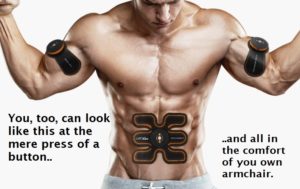
There’s not a lot of peer-reviewed research on the effectiveness or safety of EMS (Electric Muscle Stimulation) either in relation to muscle-building for improved sports performance or for therapeutic uses, for instance in case of sarcopenia (muscle wastage) in the elderly. A quick review of all the current published research studies follows in an attempt to provide you with sufficient information to make up your own mind.
All bold/underlined highlights are my additions. The full study publications are available if you follow reference notes outlined at the bottom of this article.
Blog Contents
EMS For Muscle-Building/Improved Sports Performance
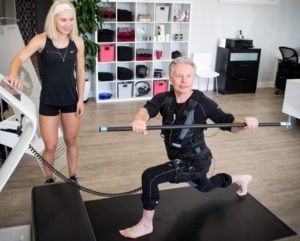
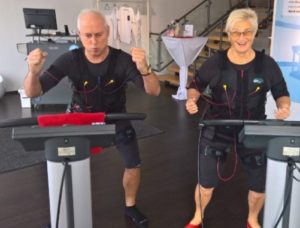
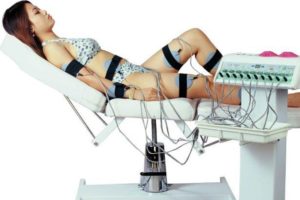
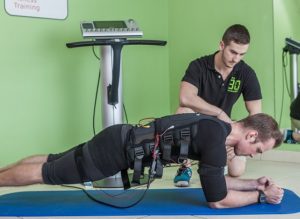
Study 1
This study1 states that “…a whole-body suit equipped with an electrical muscle stimulation device may improve cardiopulmonary factors and psychophysiological indications. However, this form of exercise is not likely to be suitable for all individuals since many find EMS difficult to tolerate. Although most subjects of the WB-EMS group tolerated it quite well and there were no participants who dropped out from the experiment, five subjects in the WB-EMS group expressed tightness and discomfort in the chest area. Therefore, it is preferable to cut off the electrical stimuli to the chest area or to refrain from adding the chest area to the WB-EMS suit when it is developed later. Further research is required to confirm the most effective methods of using WB-EMS suits, to identify the populations in which it is most beneficial, and to ensure a greater degree of medical safety. In spite of these areas, this study was the first to investigate the safety of WB-EMS through applying GXT and analyzing the effects of WB-EMS on psychophysiological variables.”
Study 2
This study2 shows that “…common strength training and strength training with superimposed EMS both enhance strength of knee and hip extensors, as well as jumping and pendulum sprint performance without improvements in linear sprint performance. However, improvements of antagonistic hamstring strength in the S+E group suggest the potential of EMS to unloaded (antagonistic) muscle groups during training. Future research should seek to establish if superimposed EMS during complex movements like sprint and jump exercises could be a possible method to achieve positive effects for sport specific performance.”
Study 3
This study3 observed that “…comparable or at least similar increases of muscle parameters after 16 weeks of WB-EMS compared with the reference method “HIT.” Thus, WB-EMS can be considered as an attractive, time-efficient, and effective option to HIT-resistance exercise for people seeking to improve general strength and body composition. On the other hand, due to the close supervision of present WB-EMS applications, this exercise technology is much more expensive. However, taking into account the fact that WB-EMS technology will become more feasible and cost efficient over the next few years, the application of WB-EMS will be increasingly implemented in commercial and noncommercial fitness settings.”
Study 4
This study 4 concluded that”…an eight week training program (with just two days per week) of EMS combined with plyometric exercises has proven useful for the improvement of every kind of vertical jump ability required for sprint and hurdles disciplines in teenage athletes. A high-frequency (≥ 150 Hz) EMS and its simultaneous application with PT can significantly contribute to the improvement of the three different types of strength manifestations (explosive, explosive-elastic and explosive-elastic-reactive strength).”
EMS For Therapeutic Purposes
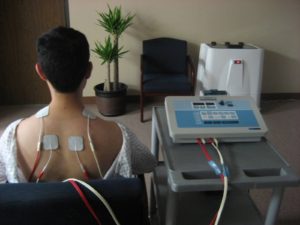
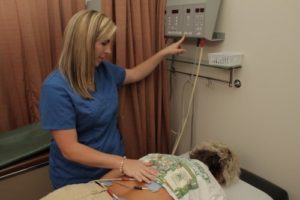
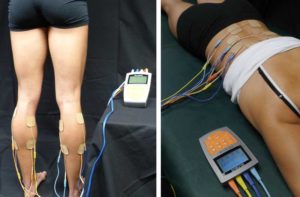
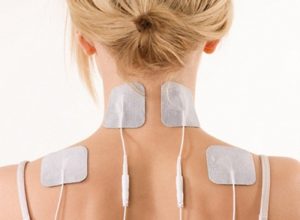
Study 5
Lower Back Pain
This study5 saw their results “…more as a preliminary finding than definitive evidence justifying a conclusion that WB-EMS has a favorable effect in the treatment of chronic, unspecific LBP [Lower Back Pain]. More dedicated WB-EMS RCTs with sufficient statistical power that focus on a homogeneous cohort of people with definite chronic and unspecific LBP and which incorporate generally accepted pain questionnaires that specifically focus on the low back region should be conducted to finally conclude this issue. Until then, WB-EMS should be regarded as a promising but still not adequately verified therapy for addressing chronic unspecific low back pain in the elderly.”
Study 6
Sarcopenia
This study6 clearly demonstrated that “…a whole-body EMS programme performed for 18 min/session, 3 sessions in 14 days, is effective for increasing muscle mass and is also safe and feasible, at least in an elderly cohort at risk for sarcopenia. Thus, we consider the application of this innovative exercise technology to be an appropriate option for elderly subjects looking to improve their body composition and muscular strength appropriately for independent and healthy aging. Taking into account that WB-EMS technology will become more feasible and cost effective over the next few years, the application of WB-EMS should be seriously considered as a means of exercise training that focuses primarily on body composition and strength parameters.”
Study 7
Sarcopenic Obesity7
This study8 pointed out that although “…our result might not be generalizable across all cohorts with sarcopenia or SO, it indicates at least the general effectiveness, safety, attractiveness, and feasibility of WB-EMS. However, taking into account the lower strain threshold of institutionalized women, we speculatively expected higher effects compared with our multimorbid but unexpectedly fit community dwelling cohort. Addressing the relevance of WB-EMS in older people with unfavorable body composition and functional limitation, we conclude that multimodal exercise protocol with endurance, resistance, and coordination would be definitely superior to WB-EMS application. However, as a matter of fact, the majority of older people are either no more capable or/and unexperienced to participate in intense and time-consuming exercise protocols. Thus, the take home message of this article is that WB-EMS can be considered as an appropriate training option for people unable or unwilling to exercise conventionally.”
Study 8
Muscle Mass/Abdominal Fat
This study9 clearly demonstrated “…WB-EMS [Whole Body-EMS] (at least combined with slight movements) applied for 18 minutes per session, on three sessions per 14 days over 12 months, has a beneficial impact on muscle mass and abdominal body fat, and is also safe and feasible, at least in this cohort of lean elderly females with limited interest in exercise. Although WB-EMS was unable to generate all the benefits of multipurpose exercise programs specifically designed for the multimorbid aged, it can be regarded as an option for subjects unwilling or unable to participate in conventional exercise programs but looking to improve their muscular fitness for independent and healthy aging.
Study 9
Thrombogenesis10
This study11 states that evidence “…supports the hypothesis that, neural supply to the veins provides direct antithrombic effects, a factor not included in Virchow’s triad. EMS appears to be one mechanism that, via neurogenic pathways, influences this 4th factor, thus suppressing thrombogenesis. As VTE remains one of the most preventable causes of in-hospital mortality, this hypothesis and factor as well as ways to affect it need to be explored. In addition, EMS needs to be investigated with well-designed RCTs for its possible additive effect on each thromboprophylactic measure, including the mechanical ones, as its implementation may save numerous lives.”
Study 10
Ostopenia12
In this study13 they found “…a borderline nonsignificant effect of WB-EMS on Bone Mineral Density at the lumbar spine and no effect at the hip. However, taking into account the high impact of this technology on muscle mass and strength, WB-EMS may be an option for musculoskeletal prevention/rehabilitation at least for (elderly) subjects unable or unwilling to exercise conventionally. Nevertheless, due to the higher impact of mixed exercise programs on BMD and their comprehensive effect on multiple risk factors and diseases of advanced age, classic exercise should be favored for elderly subjects.”
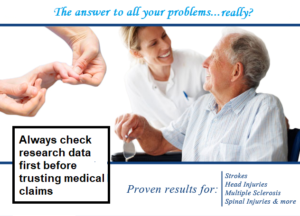
Joe’s conclusion
The person who asked my opinion on EMS (the reason why I wrote this blog) has since decided that, in spite of the largely positive results coming out of the above research (and there isn’t much more that I could lay my hands on at this moment April 2018), he would still continue to use traditional weight-lifting exercises since the cost of EMS equipment was too high for him to be able to justify its use.
The peer-reviewed research data for and against EMS is outlined above. Of course, there are hundreds of websites that praise or condemn it, but I would suggest that you always check out the facts-based research before believing any anecdotal stories or sales pitches that might simply be trying to convince you to buy their products in order to line their pockets with profits – often without the least consideration about the true usefulness to you of the products or the possible negative health implications that can result for their short- or long-term use.

References
- J Exerc Rehabil. 2018 Feb; 14(1): 49–57. Published online 2018 Feb 26. doi: 10.12965/jer.1836022.011. PMCID: PMC5833968 PMID: 29511652. The efficacy and safety of whole-body electromyostimulation in applying to human body: based from graded exercise test. Yong-Seok Jee [↩]
- J Sports Sci Med. 2016 Mar; 15(1): 26–33. Published online 2016 Feb 23. PMCID: PMC4763843. Effects of Loaded Squat Exercise with and without Application of Superimposed EMS on Physical Performance. Nicolas Wirtz, Christoph Zinner, Ulrike Doermann, Heinz Kleinoeder, and Joachim Mester. [↩]
- Evid Based Complement Alternat Med. 2016; 2016: 9236809. Published online 2016 Feb 29. doi: 10.1155/2016/9236809 PMCID: PMC4789460 PMID: 27034699. Effects of Whole-Body Electromyostimulation versus High-Intensity Resistance Exercise on Body Composition and Strength: A Randomized Controlled Study. Wolfgang Kemmler, , Marc Teschler, Anja Weißenfels, Michael Bebenek, Michael Fröhlich, Matthias Kohl, and Simon von Stengel [↩]
- J Sports Sci Med. 2012 Dec; 11(4): 727–735. Published online 2012 Dec 1. Effects of Electrostimulation and Plyometric Training Program Combination on Jump Height in Teenage Athletes. Emilio J. Martínez-López, Elisa Benito-Martínez, Fidel Hita-Contreras, Amador Lara-Sánchez, and Antonio Martínez-Amat. [↩]
- Evid Based Complement Alternat Med. 2017; 2017: 8480429. Published online 2017 Oct 18. doi: 10.1155/2017/8480429. Effects of Whole-Body Electromyostimulation on Low Back Pain in People with Chronic Unspecific Dorsal Pain: A Meta-Analysis of Individual Patient Data from Randomized Controlled WB-EMS Trials. Wolfgang Kemmler, Anja Weissenfels, Michael Bebenek, Michael Fröhlich, Heinz Kleinöder, Matthias Kohl, and Simon von Stengel [↩]
- Age (Dordr). 2014 Feb; 36(1): 395–406. Published online 2013 Aug 16. doi: 10.1007/s11357-013-9575-2. Impact of whole-body electromyostimulation on body composition in elderly women at risk for sarcopenia: the Training and ElectroStimulation Trial (TEST-III). Wolfgang Kemmler,corresponding author Michael Bebenek, Klaus Engelke, and Simon von Stengel. [↩]
- Curr Opin Clin Nutr Metab Care. Author manuscript; available in PMC 2009 Jan 30. Published in final edited form as: Curr Opin Clin Nutr Metab Care. 2008 Nov; 11(6): 693–700. doi: 10.1097/MCO.0b013e328312c37d. Sarcopenic obesity – definition, etiology and consequences. Sari Stenholm, PhD, Tamara B. Harris, MD, MS, Taina Rantanen, PhD, Marjolein Visser, PhD, Stephen B. Kritchevsky, PhD, and Luigi Ferrucci, MD, PhD [↩]
- Clin Interv Aging. 2016; 11: 1697–1706. Published online 2016 Nov 18. doi: 10.2147/CIA.S116430. Impact of whole body electromyostimulation on cardiometabolic risk factors in older women with sarcopenic obesity: the randomized controlled FORMOsA-sarcopenic obesity study. Katharina Wittmann, Cornel Sieber, Simon von Stengel, Matthias Kohl, Ellen Freiberger, Franz Jakob, Michael Lell, Klaus Engelke, and Wolfgang Kemmler [↩]
- Clin Interv Aging. 2013; 8: 1353–1364. Published online 2013 Oct 7. doi: 10.2147/CIA.S52337. Whole-body electromyostimulation as a means to impact muscle mass and abdominal body fat in lean, sedentary, older female adults: subanalysis of the TEST-III trial. Wolfgang Kemmler and Simon von Stengel [↩]
- Definition of thrombogenesis [↩]
- Springerplus. 2016; 5(1): 884. Published online 2016 Jun 24. doi: 10.1186/s40064-016-2521-x. Electrical muscle stimulation in thomboprophylaxis: review and a derived hypothesis about thrombogenesis—the 4th factor. Christos Stefanou corresponding author [↩]
- Definition of osteopenia [↩]
- J Osteoporos. 2015; 2015: 643520. Published online 2015 Feb 15. doi: 10.1155/2015/643520. Whole-Body Electromyostimulation to Fight Osteopenia in Elderly Females: The Randomized Controlled Training and Electrostimulation Trial (TEST-III). Simon von Stengel, * Michael Bebenek, Klaus Engelke, and Wolfgang Kemmler [↩]